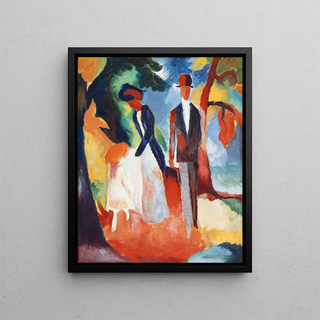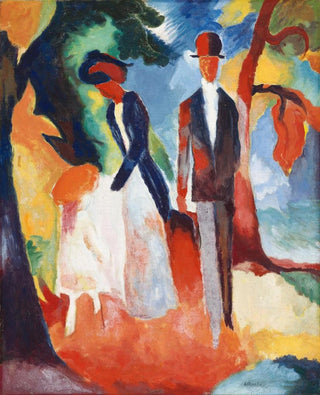Painting Les gens au bord du lac bleu - August Macke | Art print


View from behind

Frame (optional)
Reproduction Les gens au bord du lac bleu - August Macke – Captivating Introduction
In a world where nature and humanity meet in delicate harmony, "Les gens au bord du lac bleu" by August Macke stands out as an iconic work from the early 20th century. This painting, vibrant with color and light, evokes not only a snapshot of daily life but also a profound reflection on the beauty of existence. The scene depicts human figures lounging by a lake, surrounded by lush vegetation, inviting the viewer to immerse themselves in a universe where time seems suspended. The magic of this artwork lies in its ability to capture the very essence of joy and tranquility, while offering a glimpse into the innovative artistic vision of its creator.
Style and uniqueness of the work
August Macke's style is distinguished by its bold use of color and form. In "Les gens au bord du lac bleu," vivid and saturated hues blend harmoniously to create an atmosphere that is both joyful and soothing. The human figures, simplified yet expressive, are integrated into a landscape that appears almost dreamlike. The artist plays with contrasts, using shades of blue to evoke the depth of the lake while relating it to the warm colors of the characters' clothing. This chromatic approach allows for a transcendence of reality, offering a subjective and emotional view of the scene. The composition, meanwhile, is carefully balanced, guiding the viewer's eye across the painting and inviting exploration of every detail. This blend of modernity and tradition makes this work a perfect example of the expressionist movement, where emotion takes precedence over faithful representation.
The artist and his influence
August Macke, a major figure of the German expressionist movement, established himself through his originality and artistic sensitivity. Born in 1887, he was influenced by the artistic currents of his time, notably Fauvism and Cubism, while developing a style that is uniquely his own. His work is marked by a quest for beauty and harmony, reflecting his love for nature and human life. Macke also

Matte finish

View from behind

Frame (optional)
Reproduction Les gens au bord du lac bleu - August Macke – Captivating Introduction
In a world where nature and humanity meet in delicate harmony, "Les gens au bord du lac bleu" by August Macke stands out as an iconic work from the early 20th century. This painting, vibrant with color and light, evokes not only a snapshot of daily life but also a profound reflection on the beauty of existence. The scene depicts human figures lounging by a lake, surrounded by lush vegetation, inviting the viewer to immerse themselves in a universe where time seems suspended. The magic of this artwork lies in its ability to capture the very essence of joy and tranquility, while offering a glimpse into the innovative artistic vision of its creator.
Style and uniqueness of the work
August Macke's style is distinguished by its bold use of color and form. In "Les gens au bord du lac bleu," vivid and saturated hues blend harmoniously to create an atmosphere that is both joyful and soothing. The human figures, simplified yet expressive, are integrated into a landscape that appears almost dreamlike. The artist plays with contrasts, using shades of blue to evoke the depth of the lake while relating it to the warm colors of the characters' clothing. This chromatic approach allows for a transcendence of reality, offering a subjective and emotional view of the scene. The composition, meanwhile, is carefully balanced, guiding the viewer's eye across the painting and inviting exploration of every detail. This blend of modernity and tradition makes this work a perfect example of the expressionist movement, where emotion takes precedence over faithful representation.
The artist and his influence
August Macke, a major figure of the German expressionist movement, established himself through his originality and artistic sensitivity. Born in 1887, he was influenced by the artistic currents of his time, notably Fauvism and Cubism, while developing a style that is uniquely his own. His work is marked by a quest for beauty and harmony, reflecting his love for nature and human life. Macke also
12,34 €






